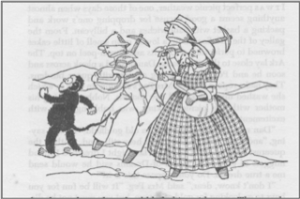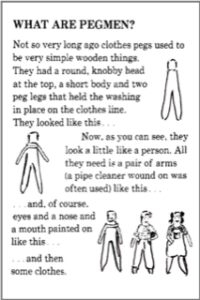By Judy Chant
Ella May McFadyen was born on 26th November 1887 in Sydney, NSW. She was the second of seven children born to fire-and-brimstone Presbyterians, Donald McFadyen and Mary (nee Wilson). Donald became General Manager of NSW Fresh Food and Ice Pty Ltd, prior to taking up the office of Mayor of Five Dock. While the boys received a good education, Ella and her four sisters stayed home to help their mother with domestic chores. They were forbidden to attend school.
Ella had a thirst for knowledge and with the help of her brothers, she taught herself to read and write, becoming a fluent Gaelic speaker, the language of her ancestors. Her interests included books, animals, bush craft, fairies and a world of imaginary beings. At 15 years of age, she began to write verses and juvenile stories for magazines. She became a feature writer for the Sydney Mail (1918-1938) and for many years, she wrote the lift-out children’s page for the newspaper. Eventually, she became a well known and respected journalist, book reviewer, poet, distinguished children’s author and a conservationist. Ella was a founding member of the Society of Women Writers, established in 1925 to encourage aspiring women writers to achieve professional status. Her poetry was published in a number of newspapers in Australia and London under the pseudonym, Cinderella. In the 1930s, dozens of letters were addressed to Cinderella from her adoring fans in Australia and abroad. These are now housed in the Mitchell Library, Sydney. Many are quite personal, thanking her for her voluntary efforts with the Red Cross during the war, or for taking the time to reply to their letters, or thanking her for the ‘little book’ she sent them (late 1930s). Some admirers related their seasonal activities on the farm, or spoke about their health and the impact of Ella’s stories and poems on their lives.
Before the time of electronic toys, children made their own toys from whatever materials were available. Most households had wooden clothes pegs to hold the washing in place on the clothes line. With a round knobbly head, a short body and two peg legs, the pegs were a common play item of children. Arms were created by twisting a pipe cleaner onto the neck, a nose, eyes and mouth were painted on the face and then clothes were added. With a touch of imagination, pegs came to life and had exotic adventures to places about which children could only dream. In 1946, the much loved Pegmen family of Mrs. Peg, her sons Dan and Nobby and the mischievous monkey, Pongo, were created as a toy fantasy from old-fashioned wooden clothes pegs that were dressed in clothes and came to life. The characters were endowed with strong personalities. Dan Pegman adopted a nautical demeanour, Mrs. Pegman played the affectionate mother and Pongo was the mischievous monkey. The Pegmen family had wonderful adventures with Australian Aborigines, bushrangers and native animals. They explored the underground wonderland of Jenolan Caves, attended a corroboree and on one occasion, travelled as far as Antarctica. The inclusion of Aboriginal culture was an integral and vibrant part of Ella’s stories.

Ella wrote about the distinctly Australian adventures of the Pegmen as a serial in the Courier Mail, followed by the New South Wales School Magazine and later, the adventures were dramatized by ABC Radio. For 93 years, The School Magazine had been Australia’s leading literary magazine for primary school students. Produced monthly, the magazine provided a mix of short stories, poems, plays, Indigenous tales, fables, non-fiction articles, puzzles, cartoons and activities.
For much of her adult life Ella and her brother, Clifford, shared a house in Lindfield, near a lyrebird gully. She kept the location to herself, stating “no friend of a lyrebird ever tells his whereabouts” (Annie Macdonald, 2FC radio interview on Ella McFadyen, titled ‘Kingship with Nature’, 1935). Birds had a strong appeal to Ella. She had the ability of becoming acquainted with their habits. In the 1940s and early 1950s, newspaper articles hailed her as a bush craft expert and camp mother to 50-100 girls at annual junior Red Cross and National Fitness camps throughout NSW.
Ella McFadyen captured the dreams of a generation of children and she produced spellbinding stories. Some of her better known publications were Songs of the Last Crusade (1917), Pegmen Go Walkabout (1947), Little Dragons of the Never Never (1948), The Wishing Star (1956) and The Big Book of Pegmen Tales (1959). The Pegmen stories were written before the days of political correctness and they offer a wonderful insight into everyday social life in the early 1900s. Little Dragons of the Never Never is a delightful day-by-day account of two little horned dragons, or lizards, from Central Australia, and how they came to live with humans. Exhibiting a genuine degree of empathy with animal life, Ella skillfully interwove factual and dreamtime information with the imagination of a child. The little horned dragons from the outback were endowed with personality. Songs of the Last Crusade is a collection of verses from World War I, with profits from the publication being donated to the War Funds. The book is dedicated to Ella’s brother and Orchardist, Private Donald Walter Lindsay McFadyen (Lindsay), of the 3 Infantry Battalion, who was in active service during the war.

Today’s children are no longer familiar with wooden clothes pegs, their imagination no longer fired by the adventures of a family of pegs. Yet to the author’s great delight, on reading the Pegmen tales to my electronically minded, well-travelled grandchildren, they sat in awed silence, devouring the words of a past era. Ella McFadyen has been described as “a heroine to hundreds of Australian boys and girls” (Migratory Songs, unnamed and undated newspaper cutting).
At 88 years of age, Ella McFadyen died on 22nd August 1976 at Lindfield, NSW. She has been described as “a heroine to hundreds of Australian boys and girls” (Migratory Songs, unnamed and undated newspaper cutting). Her notebooks and diaries are preserved in the Mitchell Library, Sydney.
